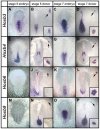Somites without a clock
- PMID: 24407478
- PMCID: PMC3992919
- DOI: 10.1126/science.1247575
Somites without a clock
Abstract
The formation of body segments (somites) in vertebrate embryos is accompanied by molecular oscillations (segmentation clock). Interaction of this oscillator with a wave traveling along the body axis (the clock-and-wavefront model) is generally believed to control somite number, size, and axial identity. Here we show that a clock-and-wavefront mechanism is unnecessary for somite formation. Non-somite mesoderm treated with Noggin generates many somites that form simultaneously, without cyclic expression of Notch-pathway genes, yet have normal size, shape, and fate. These somites have axial identity: The Hox code is fixed independently of somite fate. However, these somites are not subdivided into rostral and caudal halves, which is necessary for neural segmentation. We propose that somites are self-organizing structures whose size and shape is controlled by local cell-cell interactions.
Figures




Comment in
-
Developmental biology. Self-organizing somites.Science. 2014 Feb 14;343(6172):736-7. doi: 10.1126/science.1250245. Science. 2014. PMID: 24531958 No abstract available.
Similar articles
-
Signalling dynamics in vertebrate segmentation.Nat Rev Mol Cell Biol. 2014 Nov;15(11):709-21. doi: 10.1038/nrm3891. Nat Rev Mol Cell Biol. 2014. PMID: 25335437 Review.
-
Segment number and axial identity in a segmentation clock period mutant.Curr Biol. 2010 Jul 27;20(14):1254-8. doi: 10.1016/j.cub.2010.05.071. Epub 2010 Jul 15. Curr Biol. 2010. PMID: 20637625
-
The oscillation of Notch activation, but not its boundary, is required for somite border formation and rostral-caudal patterning within a somite.Development. 2010 May;137(9):1515-22. doi: 10.1242/dev.044545. Epub 2010 Mar 24. Development. 2010. PMID: 20335362
-
From head to tail: links between the segmentation clock and antero-posterior patterning of the embryo.Curr Opin Genet Dev. 2002 Oct;12(5):519-23. doi: 10.1016/s0959-437x(02)00335-0. Curr Opin Genet Dev. 2002. PMID: 12200156 Review.
-
Notch signalling and the synchronization of the somite segmentation clock.Nature. 2000 Nov 23;408(6811):475-9. doi: 10.1038/35044091. Nature. 2000. PMID: 11100729
Cited by
-
Sequential changes in cellular properties accompanying amniote somite formation.J Anat. 2023 Mar;242(3):417-435. doi: 10.1111/joa.13791. Epub 2022 Nov 24. J Anat. 2023. PMID: 36423208 Free PMC article.
-
Left-right symmetry of zebrafish embryos requires somite surface tension.Nature. 2022 May;605(7910):516-521. doi: 10.1038/s41586-022-04646-9. Epub 2022 Apr 27. Nature. 2022. PMID: 35477753
-
Stem-cell-based human and mouse embryo models.Curr Opin Genet Dev. 2022 Oct;76:101970. doi: 10.1016/j.gde.2022.101970. Epub 2022 Aug 18. Curr Opin Genet Dev. 2022. PMID: 35988317 Free PMC article. Review.
-
The role of self-organization in developmental evolution.Theory Biosci. 2014 Dec;133(3-4):145-63. doi: 10.1007/s12064-014-0200-4. Epub 2014 Apr 16. Theory Biosci. 2014. PMID: 24737046
-
Signalling dynamics in vertebrate segmentation.Nat Rev Mol Cell Biol. 2014 Nov;15(11):709-21. doi: 10.1038/nrm3891. Nat Rev Mol Cell Biol. 2014. PMID: 25335437 Review.
References
-
- Muñoz-Sanjuán I, Brivanlou AH. In: Gastrulation: From Cells to Embryo. Stern CD, editor. Cold Spring Harbor Press; New York: 2004. pp. 475–489.
-
- Dubrulle J, McGrew MJ, Pourquié O. Cell. 2001;106:219–232. - PubMed
-
- Dubrulle J, Pourquié O. Nature. 2004;427:419–422. - PubMed
-
- Cooke J, Zeeman EC. J. Theor. Biol. 1976;58:455–476. - PubMed
-
- Harima Y, Takashima Y, Ueda Y, Ohtsuka T, Kageyama R. Cell Rep. 2013;3:1–7. - PubMed
Publication types
MeSH terms
Substances
Grants and funding
LinkOut - more resources
Full Text Sources
Other Literature Sources

